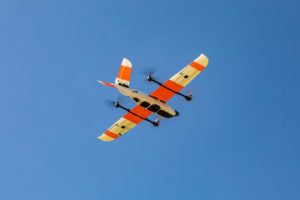



Censys Sentaero BVLOS Fixed Wing
At October’s AUVSI NE UAS and AAM Summit, BVLOS flight was a major topic of conversation. With no clear guidance on when the BVLOS rule will be released, companies must still rely upon a waiver process. Abby Smith, Deputy Executive Director , Office of UAS Integration at Federal Aviation Administration delivered a remote presentation at the Summit, and acknowledged that FAA is working to streamline the waiver system as they work to deliver a rule. “As BVLOS operations continue to expand, one-off approvals exceed the bandwidth of the FAA,” Smith said.
It’s a serious issue, one that challenges both a resource-strapped FAA and the drone industry. DRONELIFE met with Rob Knochenhauer, UAS Operations and Regulatory Specialist, about how companies can approach a BVLOS waiver application.
Knochenhauer is the Director of Regulatory Affairs at Censys Technologies, US-based manufacturer of a fixed-wing drone designed for BVLOS applications. He’s been in the drone industry since 2015, and has worked closely with the FAA as BVLOS applications have evolved. Censys has had a 100% success rate to date in working with their customers to receive waivers: and Knochenhauer says that there are 3 things applicants can do to make evaluation easier for the FAA, and increase their chance of a successful outcome.
- Read the Guidance – and Follow It. Knochenhauer says that the most important place to start is with the Waiver Safety Explanation Guidance from the FAA. “The FAA has laid out what they are looking for,” he says. “In every presentation I give, I tell companies to start there, and follow the guidelines as closely as possible.
- Don’t Make Any Assumptions. The FAA is responsible the safety and security of the National Airspace, Knochenhauer points out. “They can’t make any assumptions about what your company may or may not do, and you can’t make any assumptions about what they may infer or know about your technology.” That means spelling everything out, and being very specific about how you plan to address every contingency. The Waiver Safety Guidelines ask companies to answer “How you will ensure your operation(s) remains safe at all times, even in unusual circumstances,” and “What kinds of circumstances could arise, and how you plan to handle each.” Here, Knochenhauer says companies should answer those questions exactly, spelling out risk mitigation strategies in detail.
- Reach Out to Partners. Lastly, Knochenhauer suggests that companies partner if necessary to add critical capabilities. “You have to think carefully about what you are trying to accomplish,” he says. “For BVLOS operations, you need airspace awareness as well as to mitigate ground-based risk. You may need to partner for Detect and Avoid (DAA), or whatever the right tools are for your application.”
Read more about Censys Technologies and BVLOS flight:
Miriam McNabb is the Editor-in-Chief of DRONELIFE and CEO of JobForDrones, a professional drone services marketplace, and a fascinated observer of the emerging drone industry and the regulatory environment for drones. Miriam has penned over 3,000 articles focused on the commercial drone space and is an international speaker and recognized figure in the industry. Miriam has a degree from the University of Chicago and over 20 years of experience in high tech sales and marketing for new technologies.
For drone industry consulting or writing, Email Miriam.
TWITTER:@spaldingbarker
Subscribe to DroneLife here.





Related Posts
Drone Racing League and U.S. Air Force Launch Initiative to Support Women in STEM and Sports
Terra Drone Corporation Expands into U.S. Market through Strategic Investment in Aloft Technologies
Enhancing Photogrammetry Accuracy with Advanced GCPs Integration by SimActive and CompassData